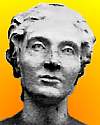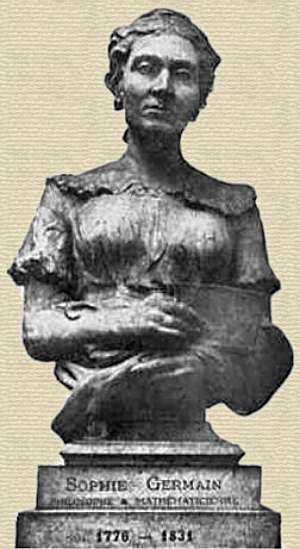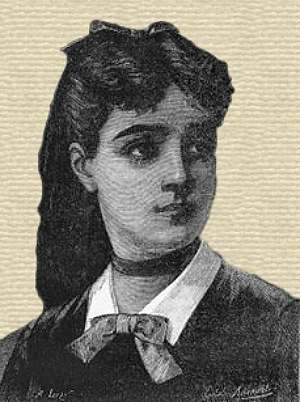 (source)
(source)
|
Sophie Germain
(1 Apr 1776 - 27 Jun 1831)
French mathematician who is known for her work in number theory and contributions to the applied mathematics of acoustics and elasticity
|
Sophie Germain.
An Unknown Mathematician.
from The Century Illustrated Monthly Magazine (1894)
[p.946] IF a thin circular sheet of metal be fastened firmly at the center by a clamp, and if a violin bow be drawn across its edge, a musical note will be produced. The plate is thrown into vibration by the bow; the vibration does not all come up at once and all go down at once, but it divides itself into some even number of sectors, say six or eight, and as one sector goes up the sector on each side of it goes down. The line between two adjacent sectors goes neither up nor down, but remains at rest. If sand be scattered evenly over the plate before the musical note is produced, it will be shaken off the parts which are most in motion, and it will collect in the lines of rest, or “nodal lines,” as they are called. Different musical notes cause the plate to be differently divided up, and the state of vibration of the plate is made plain to the eye by the lines of sand marked out on it. This experiment, a very striking one, which is still performed in all physical laboratories, was exhibited at Paris, soon after its discovery by Chladni, in 1808. It created a great sensation, and a commission was appointed to repeat it with various modifications, and to make a report upon it. The Institute of France, at the suggestion of Napoleon, offered its grand prize for a mathematical discussion of the phenomenon. There were not wanting great mathematicians in Paris at that time—Lagrange, Laplace, Legendre, Poisson, Fourier, but none of them were inclined to undertake this question; Lagrange, in fact, had said that it could not be solved by any of the then known mathematical methods. The offer was twice renewed by the Institute, and in 1816 the prize was conferred upon a woman, Mlle. Sophie Germain. It is very remarkable that so great a distinction as to have received the prize of the Institute of France for a profound mathematical discussion should not have preserved the name of Sophie Germain from oblivion, but it has not done so. There are probably not a score of persons in this country who have ever heard of her, and in her own country she is not usually mentioned among its famous women. As proof that women may be pure mathematicians, Mrs. Somerville has had, outside of Italy and Russia, to stand alone. This is unfortunate, for the detractors of her sex have maintained that her work, though exceedingly profound, was not remarkable for originality. That charge cannot be brought against Sophie Germain. She showed great boldness in attacking a physical question which was at that time entirely outside the range of mathematical treatment, and the more complicated cases of which have not yet submitted themselves to analysis. The equation of elastic laminæ, which is still called Germain’s equation, formed the starting-point of a new branch of the theory of elasticity. In her later years Sophie Germain turned her attention to questions of philosophy, and high German authority has recently discovered that her philosophical writings contain the germ of the Positive Philosophy of Comte. It is a curious thing that a woman so deserving of recognition has not received it in a fuller degree; it must be looked upon as one of those accidents by which the distribution of praise for merit is too often badly regulated. A mathematician, so remote is his subject from the ordinary concerns of men, has to be a very great mathematician indeed to be so much as heard of by the general public. Sophie Germain, besides deserving remembrance on account of her contributions to science, had a charming personality, and the few details that have been preserved concerning her life will not be found to be without [p.947] interest. The authority for them is an article by Libri, the Italian mathematician, which appeared in the “Journal des Débats” at the time of her death. Later writers, including the author of the biography prefixed to the new edition of her philosophical works, which was published in 1879 (Paris: P. Ritti), have added little that is important to his account.
On April 1, 1776, in a modest house in the Rue Saint Denis, in Paris, Marie Sophie Germain was born. Her parents were Ambroise Francois Germain and Marie Madeleine Gruguelu. Not much can be said about her family. It is only known that her father, a skilful goldsmith, belonged to the cultivated and liberal bourgeoisie, and that he was the partizan, if not the friend, of the philosophers and the political economists. It is plain that she must have passed her earliest years in a family in which there were plenty of serious subjects for conversation. She soon exhibited great maturity of intellect, and remarkable depth of feeling. Her gloomy anticipations concerning the future of her country were a distinct cause of suffering to her, and she sought for some occupation sufficiently absorbing to distract her attention from her fears. At the age of thirteen she was one day turning over the pages of Montluca’s “History of Mathematics” in her father’s library, when she came upon the eloquent account of the death of Archimedes—how he was so absorbed in the consideration of a geometrical figure that he heard nothing of the taking of Syracuse, or of the plundering of the city, and that, when a Roman soldier appeared before him, he met death at his hands without raising his eyes from his work. She conceived a sudden passion for a science which could procure such absolute concentration and such total oblivion from the cares and griefs of life, and she resolved at that moment to devote herself to the study of mathematics. That resolution she carried out. She had no teachers, she had few books, but she had an unlimited store of energy. She studied by day and by night. Her family were alarmed at so much ardor, and endeavored to turn her attention to more ladylike pursuits. They tried the plan of putting out her fire and taking away her clothes at night, but she was found in the morning wrapped up in blankets, absorbed in her studies in a room so cold that the ink was frozen in the inkstand. It is a curious coincidence that Mrs. Somerville, at that very same time, in her little village in Scotland, was obliged to wrap herself up in blankets to pursue her studies before breakfast, because her whole day had to be devoted to the practice of music and painting, and to her lessons at the shop of the pastry-cook.1 Before a strength of will so remarkable at her age Sophie Germain’s family at last yielded, and she was allowed to dispose of her time and her talents at her pleasure.
But no matter what the energy brought to bear upon them, the higher mathematics present a long and toilsome course of study to any one who wishes to master them. Sophie Germain carried on this laborious work with constantly increasing satisfaction. Toward the end of her life, she still spoke with animation of the happiness she experienced when she first found herself in a position to take up the Differential Calculus of Cousin. But soon a new difficulty presented itself. It was absolutely necessary to her further progress that she should read certain works which were written in Latin, and she did not understand that language. Unaided and alone, she proceeded to learn it, and in a short time she was able to read the works of Euler and Newton. Her ambition at this time took a wider range, and, carried away by the philosophical spirit which held sway in the great encyclopedia, she extended her reading over the entire field of the sciences, and laid the foundations for that work which, forty years later, was to secure her a place among the founders of the Positive Philosophy.

By Zacharie Astruc - Reconstructed from death mask in the museum of the Louvre. (source)
In 1794 the École Polytechnique was founded. Lagrange, Prony, Fourcroy, Monge, were among its lecturers. Sophie Germain was then eighteen years of age. Anxious to profit by so valuable a means of instruction, she procured for herself students’ note-books specially of the courses in chemistry of Fourcroy, and in analysis of Lagrange. She did more. The students were in the habit of handing in to the professors, at the end of a course, their observations in writing on the lectures which they had attended. Under the supposed name of a student, Le Blanc, she sent her note-books to Lagrange. He noticed them, publicly praised them, found out their real author, and, having made her acquaintance, became the friend and counselor of the young mathematician. The circumstances under which she was discovered, the approbation of the illustrious author of the “Mécanique Analytique,” her youth, some details concerning her studies—all this excited [p.948] attention, and procured for her sympathetic friends. Soon she had established relations, either directly or by correspondence, with all the learned men of the period. Every one was solicitous of the honor of being presented to her, learned works were dedicated to her, and her house became a center for the brilliant conversation of the most distinguished men of the day.
Some years later, Gauss’s great work on the “Theory of Numbers” appeared. Mlle. Germain at once turned her attention to this subject. She made numerous researches in it, and, under the pseudonym of Le Blanc, she sent her notes to the celebrated professor of Göttingen, persuaded, she writes, that “he will not disdain to enlighten with his advice an enthusiastic amateur of that science which he cultivates with such brilliant success.” M. Le Blanc was far from being a simple amateur, and Gauss was soon well aware of it. His answer contained a warm recognition of her talents, and a friendly intercourse was kept up between them for several years without his becoming aware of the sex of his correspondent.
In 1808 Sophie Germain contended for the prize offered by the Institute for the best memoir giving the mathematical theory of elastic surfaces, and comparing it with experience. She deduced the equation of those surfaces from a certain hypothesis concerning the forces of elasticity, but there was an error in her mathematics, and her equation was not correct. Lagrange, to whom the paper had been referred, deduced from the same hypothesis the equation which is still recognized as the correct one. She did not receive the prize. Two years later she sent in a second memoir, in which the same equation is correctly given, and a more complicated hypothesis leads to the equation for the state of things which obtains at the boundaries of the elastic plate. Her theoretical solution she had also confirmed by a long series of experiments. This paper received honorable mention. Nothing daunted, she tried a third time, and received the prize, although the commission was not absolutely satisfied with the rigor of her demonstration. Germain’s equation for elastic plates is still the fundamental equation of the theory. Her boundarye quations have not stood the test of time; Poisson, fourteen years later, gave a different set of boundary-equations based upon a different hypothesis, and Kirchoff, in 1850, showed that neither hypothesis was tenable, and that neither set of equations was correct.
In 1824 she sent another paper to the Institute entitled, “On the Employment of the Thickness in the Theory of Elastic Surfaces.” This paper was given to a commission, consisting of Poisson, Prony, and Laplace, to report on. They never brought in their report, and she was never able to regain possession of the manuscript. Only a few years ago it was discovered among the papers of Prony, and it was reprinted entire, in a supplement to Liouville’s “Journal des Mathématiques.”
Not spoiled by her success, Sophie Germain continued her studies with all her former enthusiasm. She attended the sessions of the Academy of Sciences, kept herself abreast of the scientific researches of her contemporaries, and found time to perform various friendly offices for her acquaintances. She contributed to the “Annales de Physique et de Chimie” an examination of the principles which lead to the laws of movement of elastic solids. In this paper she establishes, in opposition to Poisson, that no hypothesis in regard to the molecular constitution of bodies is necessary in a discussion of elasticity. Her views on this subject have been abundantly confirmed. Two papers of hers in “Crelle’s Journal”—one on the curvature of surfaces, and one on the theory of numbers—were composed by her during the noise of the cannon of July, 1830. Her hope of finding a profound absorption in the study of mathematics had not been disappointed.
There, are many testimonials to the charm of her character and of her conversation. She was imbued with a pure love of science, and she was remarkably indifferent to her own fame. She rejoiced when ideas which she had let fall in conversation were appropriated by others. It made no difference, she said, from whom an idea came; it was only of consequence that it should be true and useful. Fame she defined to be the small space which one occupies in the brain of his neighbors—a definition which Schopenhauer has since repeated. Virtue she looked upon as a sense of order, which the cultivated understanding must admire, even when the heart does not love it. Her conversation was full of gaiety and freshness, and bore constant marks of originality of thinking, and of a poetic handling of her thoughts. She died at the age of fifty-five. Her grave at Père la Chaise, fifteen steps from that of Comte, is in a neglected condition. The railing is rusty, the stone has fallen, the border of box is wild and overgrown.
The philosophical writings of Sophie Germain were given to the world two years after her death, by her nephew, Lherbette. Besides some detached thoughts, they consist of a long article entitled, “Considerations on the State of the Sciences and of Letters at the different Periods of their Culture.” Her main idea is the extension of the principles of law, and of the harmonious interaction of causes which prevail in the physical sciences, to the [p.949] regions of politics, of morals, and of art—the same idea which Comte expounded with much greater detail in his “Cours de Philosophic Positive.” Comte’s indebtedness to Condorcet and to Saint-Simon has frequently been mentioned. It is only recently that it has been discovered how distinctly he was anticipated in the main features of his system by Sophie Germain. Dühring, in his “Critical History of Philosophy from its Beginnings to the Present Time” (third edition, Leipsic, 1878), says, after giving a full abstract of her work, “One sees from the above that the Positivism which, without the use of the word, one finds in the writings of Sophie Germain, contains the essential features of that which has hitherto been associated with the name of Auguste Comte.” The “Zeitschrift für Philosophic” has had two long articles by Göring entitled: “Sophie Germain as the Predecessor of Comte.” Her “Considerations” are still very interesting reading, and they would well repay translation.
- Science Quotes by Sophie Germain.
- 1 Apr - short biography, births, deaths and events on date of Germain's birth.
- Sophie Germain: An Essay in the History of the Theory of Elasticity, by L.L. Bucciarelli, N. Dworsky. - book suggestion.





